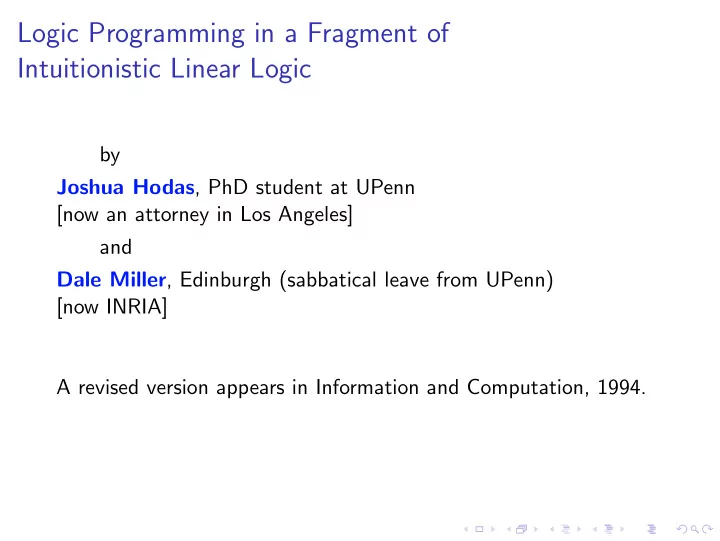

Logic Programming in a Fragment of Intuitionistic Linear Logic by Joshua Hodas , PhD student at UPenn [now an attorney in Los Angeles] and Dale Miller , Edinburgh (sabbatical leave from UPenn) [now INRIA] A revised version appears in Information and Computation, 1994.
Remembering the early 1990’s Two new, exciting innovations: • linear logic [1987] • π -calculus [1989] Many areas of computational logic, concurrency theory, and programming language semantics have been influence by them. . . . but there was a steep learning curve. Linear logic was strange: proof nets, slices, phase semantics, additive/multiplicative/exponential connectives, etc. The LICS 91 paper showed that • logic programming became more expressive using linear logic, and • linear logic programming had applications.
In the ’91 and ’94 papers Lolli = {⊤ , & , ∀ , ⊃} ∪ { ⊸ } • Linear logic without exponentials: LL = Lolli ∪ {⊥} • Completeness of “goal directed search” • A polarized embedding of intuitionistic logic into linear logic (needs half as many exponentials). • A canonical model given as a resource indexed Kripke model • Lazy splitting of contexts • Several applications.
(from LICS91) Aspects of Intuitionistic Contexts Theorem Proving + Contexts manage hypotheses and eigen-variables elegantly. − Contraction cannot be controlled naturally. Linguistics + Relative clauses are sentences with noun phrase gaps: ( NP ⊃ SENT ) ⊃ REL . − Gap extraction is non-vacuous and satisfy island constraints Data Bases + Contexts can act as databases and support query answering by deduction. − Contexts cannot naturally be “edited” or updated. Object State + Objects can have their state and methods hidden in a context. − Updating object state is not possible declaratively. The linear logic extension changed the minuses to pluses.
A word about the future (paraphrasing The Graduate ) Mr. McGuire: I just want to say one word to you. Just one word. Ben: Yes, sir. Mr. McGuire: Are you listening? Ben: Yes, I am. Mr. McGuire: Focused proof systems Ben: But isn’t that three words? Focused proof systems provide control of the structural rules without a direct appeal to linear logic. They provide remarkably flexible normal forms. Completeness of a focusing proof systems is the second most important result about a sequent proof system for CS applications. Mr. McGuire: But what is the most important result? Ben: Cut-elimination, of course. — Thank you —
Recommend
More recommend